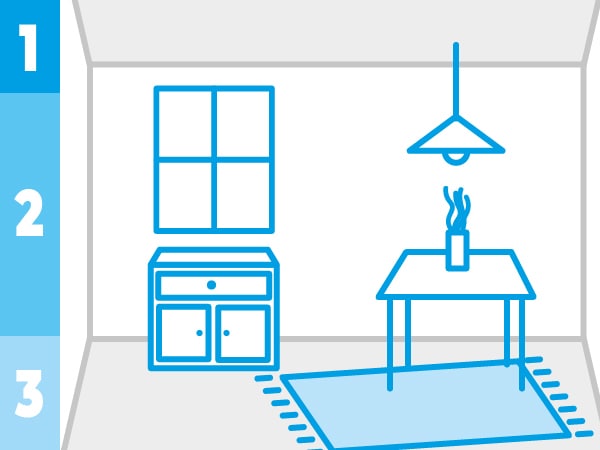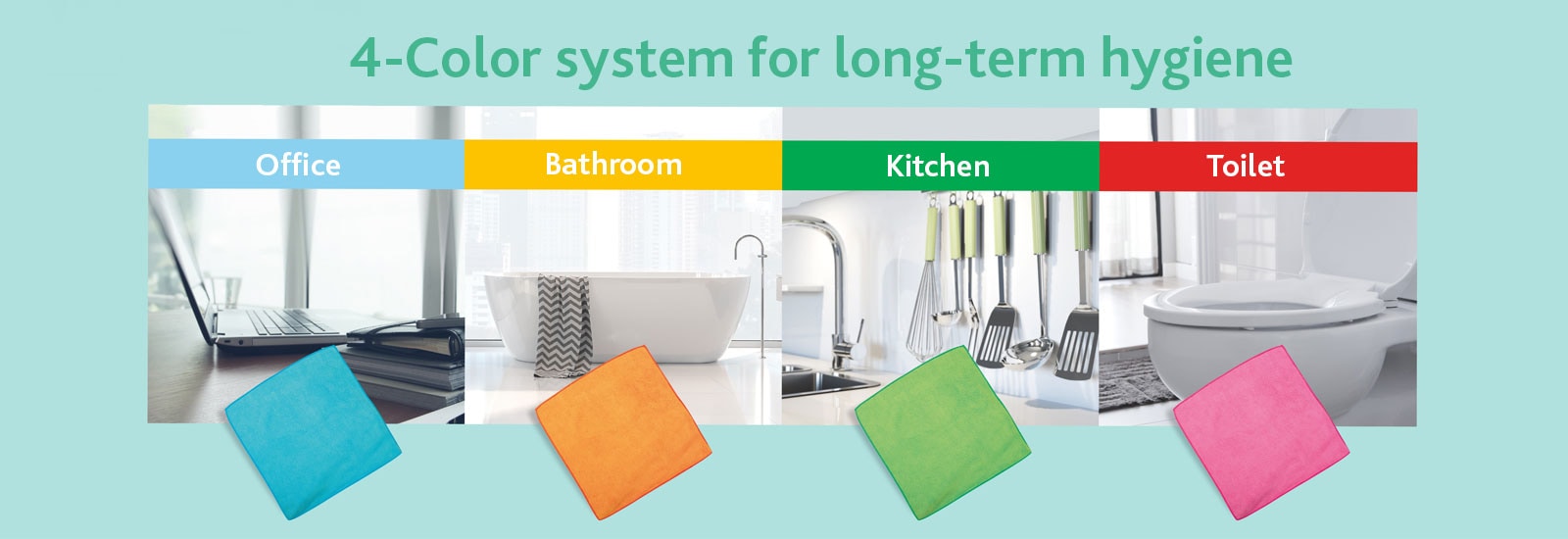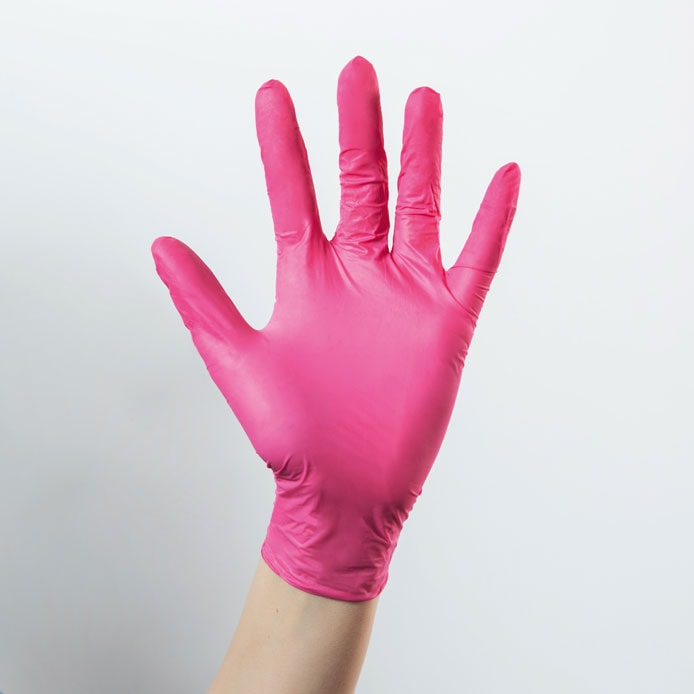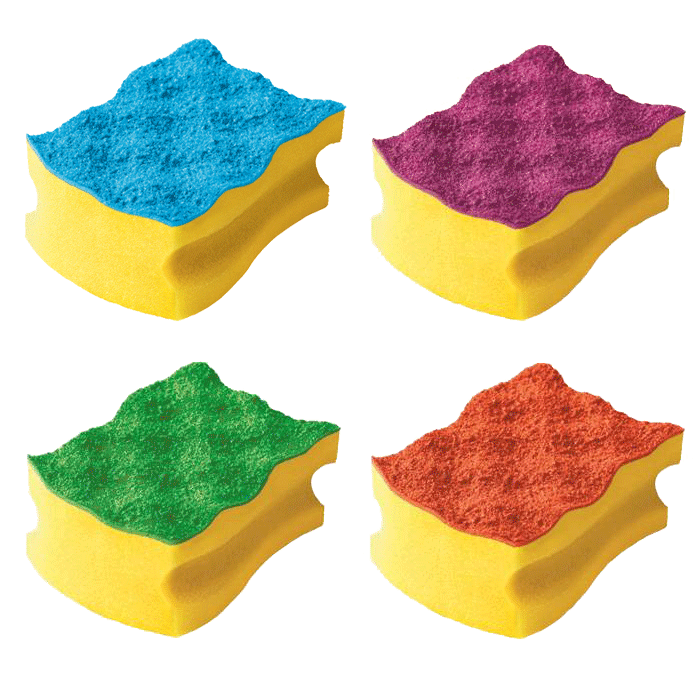Colour up your cleaning!
Now more than ever home is a place to feel safe and we want you to feel great in your own four walls. We do everything we can to keep it like that. With our expertise in cleaning, durable products and clever techniques we fight bacteria, germs and viruses and their contamination. Throw out your old cleaning habits and upgrade with these techniques, tips and tools: for hygiene at home.
4-Color Coding system
The basic thinking behind Colour Coded Cleaning: Use colours to segregate the different types of tasks you have to carry on areas you have to clean to avoid cross contamination of bacteria, germs and viruses.
This easy system is an established cleaning standard in professional environments like hospitals and restaurants where cross contamination will lead to illness. There you would not want to clean the surfaces of a kitchen with a cloth that has been previously used to clean the toilet bowl (bathroom tiles). The best practice in a hospital should be good enough for your home.
This easy system is an established cleaning standard in professional environments like hospitals and restaurants where cross contamination will lead to illness. There you would not want to clean the surfaces of a kitchen with a cloth that has been previously used to clean the toilet bowl (bathroom tiles). The best practice in a hospital should be good enough for your home.
Colour coding can be broken down into 4 areas:
For this system to work you will need to assign different colours of cleaning cloths to each area, making it easily identifiable. This hygienic cleaning system can be applied to any cleaning equipment used in each area: e.g. from microfiber cloths to scouring sponges.
Regular change of refills
As bacteria, viruses and germs multiply particularly well in a moist environment it is important to let the cleaning equipment dry well and change or wash cleaning cloths frequently.
All Vileda cloths and scouring sponges are very durable and can be washed at a temperature of at least 60° C or higher.
Sustainable cleaning and washing begins by using several refills at home and washing them all together.
All Vileda cloths and scouring sponges are very durable and can be washed at a temperature of at least 60° C or higher.
Sustainable cleaning and washing begins by using several refills at home and washing them all together.
The right way of cleaning – everywhere

Bacteria especially love moist environments and like to multiply where we don't expect them to. However how to clean? First the floor, then the shelves, or the other way around?
Our hygiene concept will not only save you time, but will keep your home 99 % bacteria-free from top to bottom. And here's the first secret of the concept: "top to bottom" is in itself the perfect cleaning system: Start with ceilings. Then tackle work surfaces, tables and drawers. Vertical cleaning.
Our hygiene concept will not only save you time, but will keep your home 99 % bacteria-free from top to bottom. And here's the first secret of the concept: "top to bottom" is in itself the perfect cleaning system: Start with ceilings. Then tackle work surfaces, tables and drawers. Vertical cleaning.
Special tips for each area:
Special tips for each area:
HOME OFFICE
In the current worlds climate more and more people are moving into their own four walls for mobile work or home office. Whether this is short-term or long-term: bacteria multiply on frequently touched hardware: the desk, laptop or keyboard.
Use separate cleaning cloths for work surfaces and hardware
Remove crumbs and coarse dirt carefully from your computer or laptop keyboard with a vacuum cleaner. Gently wipe gaps with cotton swabs, a toothbrush or even toothpicks.
Deep clean the mouse or keyboard with a damp microfiber cloth. Remove stubborn dirt with a damp, but thoroughly wringed cloth.
Remove dust from the monitor with a soft microfiber cloth and wipe grease fingers etc. with a damp microfiber cloth.
Tip: Clean the screen or keyboard with caution, as the sensitive hardware can quickly be damaged.
Use separate cleaning cloths for work surfaces and hardware
Remove crumbs and coarse dirt carefully from your computer or laptop keyboard with a vacuum cleaner. Gently wipe gaps with cotton swabs, a toothbrush or even toothpicks.
Deep clean the mouse or keyboard with a damp microfiber cloth. Remove stubborn dirt with a damp, but thoroughly wringed cloth.
Remove dust from the monitor with a soft microfiber cloth and wipe grease fingers etc. with a damp microfiber cloth.
Tip: Clean the screen or keyboard with caution, as the sensitive hardware can quickly be damaged.
BATHROOM
Use separate cleaning cloths for the sanitary area – shower, washbasin, tiles.
Wipe doorknobs, light switches and other hand-contact surfaces regularly.
Set free the cistern and lid of the toilet from germs. A large population of bacteria live here and is easily spread on by your hands.
Bacteria love to multiply in wet rooms. To prevent this wipe or squeeze the surfaces dry with separate cleaning cloths or a squeegee right after showering or washing.
Wipe doorknobs, light switches and other hand-contact surfaces regularly.
Set free the cistern and lid of the toilet from germs. A large population of bacteria live here and is easily spread on by your hands.
Bacteria love to multiply in wet rooms. To prevent this wipe or squeeze the surfaces dry with separate cleaning cloths or a squeegee right after showering or washing.
KITCHEN
Use separate cleaning cloths for dishes and work surfaces
Allow scouring sponges, hand and tea towels to dry
Regularly clean the sink, work surfaces, kitchen appliances and door or cabinet handles with warm water
Empty the waste container frequently and wash it out with warm water and detergent at least once a week. Wash regularly at at least 60°C.
The dishwashing brush should be washed regularly in the dishwasher.
Allow scouring sponges, hand and tea towels to dry
Regularly clean the sink, work surfaces, kitchen appliances and door or cabinet handles with warm water
Empty the waste container frequently and wash it out with warm water and detergent at least once a week. Wash regularly at at least 60°C.
The dishwashing brush should be washed regularly in the dishwasher.
TOILET
Wash out your cleaning cloths and clean the toilet seat well on both sides.
Use gloves to protect your hands
Scrub the toilet rim and interior with the toilet brush or separate scouring sponge.
Frequently contacted areas should be washed more often with a separate cloth: for example the flush button, door handle and toilet brush.
Use gloves to protect your hands
Scrub the toilet rim and interior with the toilet brush or separate scouring sponge.
Frequently contacted areas should be washed more often with a separate cloth: for example the flush button, door handle and toilet brush.






